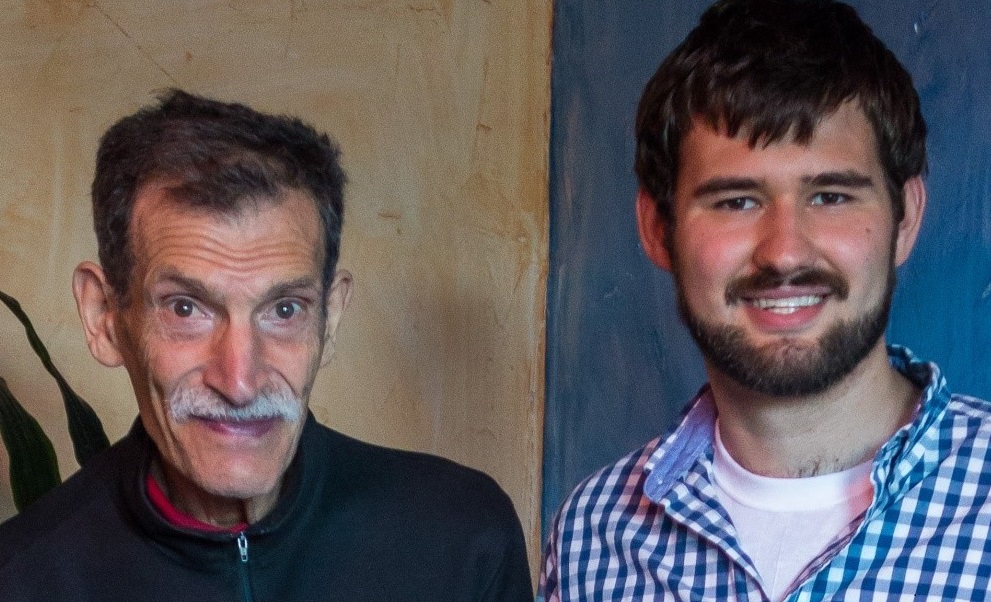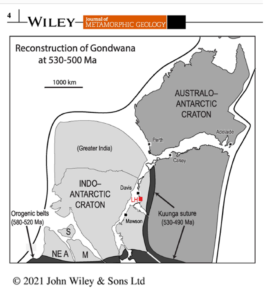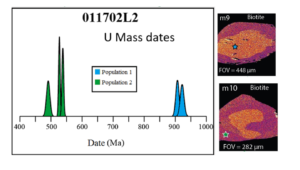
University of Maine Geology Team reports new pressure-temperature-time data relevant to the India-Antarctica Suture in the Gondwana Supercontinent
The Larsemann Hills on the coast of Prydz Bay in East Antarctica have been the focus of intense geologic interest because of their key location close to the orogenic zone along which the continents of India and Antarctica collided about 500 million years ago during the assembly of the supercontinent Gondwana. Not only do the minerals and rocks of the Larsemann Hills record the Cambrian Pan-African orogeny, which sutured Gondwana, but they also contain evidence of a much older orogeny of colliding continents which formed the supercontinent Rodinia about 900 million years ago. During that collision, the Indo-Antarctic Craton and neighboring East Antarctica are considered to have been caught up together in the same orogenic events of mountain building, metamorphism and partial melting.
Figure 1 shows a reconstruction of how the southern continents fit together in the supercontinent Gondwana in Cambrian time 530-500 Ma (million years ago). The map is based on work by Dr. Steven Boger at the University of Melbourne. LH is the central location of the Larsemann Hills in East Antarctica. (NE A = northeast Africa; S = Seychelles and M = Madagascar) The Kuunga Suture is thought to have been an ancient tectonic convergence zone which today lies hidden below the Antarctic ice, marking the final collision of West Gondwana with the Australia-Antarctic cratons.

Spreitzer et al. (2021) J. Metamorphic Geology Fig. 3, online 24 April 2021, used by permission.
The Larsemann Hills lie between the two Australian Antarctic scientific stations Mawson and Davis (Figure 1), and are also the location for the stations Zhongshan (China), Bharati (India), Progress (Russia), and Law-Racoviță (Romania, donated by Australia). Scientists from the Chinese, Indian, Russian and Australian expeditions are actively publishing research on the geology of the Larsemann Hills and contiguous areas along the coast of Prydz Bay and in the Lambert Glacier-Amery Ice Shelf area. To protect the environmental and scientifically significant geologic features of the Larsemann Hills, a joint nomination was put forward in 2007 by Australia, China, India, Romania and the Russian Federation to have the Larsemanns designated as an Antarctic Specially Managed Area (ASMA). Within that ASMA, the same nations further proposed that Stornes Peninsula be designated an Antarctic Specially Protected Area in 2014. These environmental protections are both currently in place under the Antarctic Treaty.
Steven Spreitzer (Maine MS 2017) and Jesse Walters (Maine PhD 2020) have just published their contribution to the international literature on the Larsemann Hills in collaboration with Prof. Edward Grew. Grew has had a long interest in supercontinent reconstructions involving India and Antarctica, and he has collaborated with Australian Antarctic geologists since 1977. Grew discovered three new borosilicate and phosphate minerals in the Larsemann Hills (boralsilite, tassieite and chopinite) and helped lead the Australian effort to enact the Antarctic Treaty protections. After an Indo-American Fellowship in 1980-81, Grew published in 1986 with William Manton the first Neoproterozoic radiometric ages obtained for the Eastern Ghats province of India, which matches up with East Antarctica in the Rodinia reconstruction. In a series of papers with Robert Hazen, Grew has shown how the supercontinent cycle has had special influence on boron, beryllium and lithium mineral evolution during Earth history.
In their new paper in the international peer-reviewed Journal of Metamorphic Geology, Spreitzer dated monazite crystals and Walters calculated phase diagrams in order to discern the pressure-temperature-time histories of the rocks caught up in the amalgamation of the two supercontinents of Gondwana and Rodinia. Their work has also revealed the histories of exhumation and cooling of the rocks over time following the peak of metamorphism and partial melting. In order to constrain the timing of metamorphism and anatexis associated with continental movements and suturing, monazite crystals were dated in-situ with the electron microprobe. Monazite grains were selected for dating using maps of U, Th, Y, and Pb contents to identify growth domains.

Figure 2 shows two tiny crystals of monazite in false colors revealing the ancient cores of the crystals which still retain ages from 900 million years ago, overgrown by younger monazite in the outer portions of each crystal which grew during the Cambrian metamorphism. Spreitzer’s analyses of multiple monazite crystals yielded two populations of ages as shown in the chart, the ages of the crystal cores corresponding to the assembly of the earlier Rodinia supercontinent and the outer parts of the crystals with Cambrian ages corresponding to metamorphism during Gondwana assembly.
Grew first visited the Larsemann Hills, East Antarctica with the 18th Soviet Antarctic Expedition in 1973. He returned November 2003-February 2004 with the Australian Antarctic Research Expedition to what was to be his last career expedition to Antarctica. The paper by his student Spreitzer is the 11th research paper which Grew has published on the rocks he collected in the Larsemann Hills. He and his field partner Chris Carson were supported on the Australian Antarctic Research Expedition by the Australian Antarctic Division and the U.S. National Science Foundation. Carson is now in the Onshore Energy Systems Section, Energy Systems Branch of the Minerals, Energy and Groundwater Division, Geoscience Australia based in Symonston near Canberra. Carson specializes in metamorphic petrology, geochronology and structural geology. He has been with Geoscience Australia since 2006 and in 2017 joined the Onshore Energy program, working in the South Nicholson region of the Northern Territory of Australia.
Carson is co-author on 7 and Dr. Martin Yates at Maine is co-author on 8 of Grew’s Larsemann Hills papers. Yates is Laboratory Manager and Instructor in the School of Earth and Climate Sciences, and recently celebrated 35 years of service at UMaine. The specimens that Grew and Carson collected have provided the subject material for 3 Master’s degree theses by Grew’s students at U Maine: Eva Wadoski (2009), JohnRyan MacGregor (2012) and Steven Spreitzer in 2017.
First author Steven K. Spreitzer says “I am glad that the chemical and age data I collected on monazite and interpreted as part of my Masters thesis have contributed to our understanding of the tectonic history of East Antarctica.” Spreitzer thanks the Geological Society of America for a GSA Graduate Student Grant which funded his analyses of Th, U, and Pb in monazite for age dating with the Cameca SX Ultrachron under the direction of Michael Williams and Michael Jercinovic at the University of Massachusetts-Amherst. The Ultrachron is one of the leading monazite dating facilities in the world. Two University of Maine Graduate Student Government Grants and funds from the School of Earth and Climate Sciences supported Spreitzer’s research and mineral analyses with Martin Yates on the Cameca SX 100 electron microprobe at the University of Maine. Prior coming to Maine, Spreitzer graduated summa cum laude in Geology from the State University of New York in New Paltz in 2015. With Prof. Grew as Advisor, he received his MS in Earth and Climate Science from UMaine-Orono in 2017. He is now Project Scientist at Peak Environmental LLC in East Brunswick, NJ where he works on environmental remediation projects for contaminated properties.
After Spreitzer completed his thesis, Grew suggested that UMaine PhD student Jesse Walters be invited to calculate pseudosections for the mineral assemblages Spreitzer had analyzed. A pseudosection is an equilibrium phase diagram showing the pressure and temperature fields of stability for different equilibrium mineral assemblages for a single bulk-rock chemical composition. The calculation is so complicated that it is necessary to use sophisticated phase equilibria modeling programs. Walters had become highly proficient in creating phase diagrams using the Perplex thermodynamic calculation package, and so he contributed these calculations and diagrams to the manuscript. Pseudosections are now routinely expected for papers published in the Journal of Metamorphic Geology. Walters (Maine PhD 2020) was a Fulbright Fellow (2019-2020) and currently is a postdoctoral research associate at Goethe Universität in Frankfurt am Main, Germany, where he studies the redox chemistry of subduction zones. He was the UMaine 2020 Edith M. Patch Outstanding PhD Student in the College of Natural Sciences, Forestry, and Agriculture.
Walters says: “I enjoyed the opportunity to study these unique Antarctic rocks, which record the formation of the supercontinent Gondwana, a very important part of Earth’s tectonic history. In my contribution, I used the thermodynamic properties of minerals to predict how the pressure, temperature, and composition of the rocks changed during metamorphism, allowing us to link the monazite dates and compositions to specific events, such as melting of the rocks at high temperatures.
Corresponding author Dr. Alicia Cruz-Uribe served on Spreitzer’s MS thesis committee and was the doctoral thesis advisor for Walters. She is the newly tenured Edward Sturgis Grew Associate Professor of Petrology and Mineralogy in the School of Earth and Climate Sciences. Her research interests span many aspects of metamorphic petrology and high-temperature geochemistry, with her primary focus on geochemical cycling in subduction zones. Cruz-Uribe says “It has been a wonderful opportunity to work on the Larsemann Hills project with this team of scientists. One of the best things about this project was that it presented special opportunities for our graduate students to learn new skills and work with a really knowledgeable team of specialists. I personally have enjoyed expanding my own research on metamorphism by working for the first time on rocks from Antarctica.”

